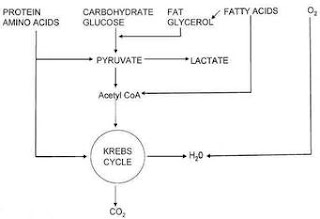The pathophysiology of type 1 diabetes mellitus (IDDM) - The autoimmune damage of pancreatic β-cells leads to lack of insulin production which results in the metabolic disorder associated with insulin dependent diabetes mellitus (IDDM)/ type 1 diabetes mellitus. In addition to the deficit of insulin secretion, the function of pancreatic α-cells is also disturbed and there is excessive production of glucagons in patients with IDDM.
Usually, hyperglycemia condition leads to reduced glucagons secretion, however, in IDDM patients, glucagons output is not suppressed by hyperglycemia condition. The resultant inappropriately elevated glucagons levels worsen the metabolic defects due to insulin deficiency. The most obvious example of this metabolic disturbance is that patients with IDDM rapidly generate diabetic ketoacidosis condition in the absence of insulin administration. Although insulin deficiency is the primary defect in IDDM, there is also an error in the administration of insulin. Multiple biochemical mechanisms account for impairment of tissue’s response to insulin. Insulin deficiency leads to uncontrolled lipolysis and increased levels of free fatty acids in the plasma, which depress glucose metabolism in peripheral tissues such as skeletal muscle. This impair of glucose utilization and insulin deficiency also decreases the expression of some genes that essential for tissues to respond normally to insulin such as GLUT 4 class of glucose transporters in adipose tissue and glucokinase in the liver. Raju and Raju (2010) explained that the significant metabolic disorders, which result from insulin deficiency in IDDM patients are impaired glucose, protein, and lipid metabolism which are described in details as follows:
Effects on Glucose Metabolism
Uncontrolled IDDM can increase hepatic glucose production. First, stores of liver glycogen are mobilized then hepatic gluconeogenesis is used to produce glucose. Insulin deficiency also harms non-hepatic tissue utilization of glucose. Especially in skeletal muscle and adipose tissue and, insulin also stimulates uptake of glucose. This process is accomplished by insulin mediated movement of glucose transporters proteins to the plasma membrane of these tissues. Reduced uptake of glucose by tissues on the peripheral, in turn, leads to a reduced rate of glucose metabolism. Also, the level of hepatic glucokinase is organized by insulin. Therefore, a reduced rate of glucose phosphorylation in hepatocytes leads to increased delivery to the blood. Other enzymes involved in the anabolic metabolic metabolism of glucose are affected by insulin.
The combination of increased hepatic glucose production and reduced peripheral tissues metabolism leads to the elevated level of plasma glucose. When the kidneys capacity to absorb glucose is suppressed, glucosuria happen. Glucose is an osmotic diuretic. An increased glucose loss in renal is participated by the loss of electrolyte and water. The outcome of the loss of water (and overall volume) aims to the activation of the thirst mechanism (the patient become polydipsia). The negative caloric balance, which proceeds from the glucosuria and tissue catabolism leads to an increase in appetite and food intake (the patient become polyphagia.)
Effects on Protein Metabolism
Insulin manages the synthesis of many genes, either positively or negatively, which influence overall metabolism. Insulin has an overall effect on the metabolism of protein, increasing the rate of protein synthesis and decreasing the rate of protein reduction. So, the deficiency of insulin will lead to greater catabolism of protein. The increased rate of proteolysis leads to elevated concentration of amino acids in plasma. Glucogenic amino acids serve as precursors for hepatic and renal gluconeogenesis, which further contributes to the hyperglycemia seen in IDDM.
Effect on Lipid Metabolism
 |
| Protein, Glucose, and Fatty Acids Metabolism |
One primary role of insulin is to stimulate the depository of food energy in the shape of glycogen in the liver cell (hepatocytes) and skeletal muscle, following the consumption of a meal. Also, insulin stimulates hepatocytes to synthesize and reserve triglycerides in adipose tissue. In an uncontrolled patient with IDDM, there is a fast mobilization of triglycerides leading to increased rates of free fatty acids in the plasma. The free fatty acids are taken up by generous tissue (except the brain cells) and metabolized to produce energy. In the lack of insulin, malonyl COA levels down, and movement of fatty acyl-COA into the mitochondria increases. The mitochondrial oxidation of fatty acids produces acetyl COA that can be further oxidized in the TCA cycle. However, in hepatocytes, most of the acetyl COA is not oxidized by the TCA cycle but is metabolized into the ketone bodies (i.e. acetoacetate and b-hydroxybutyrate). These bodies of ketone are used for energy production by the heart, brain, and skeletal muscle. In IDDM patient, the increased availability of free fatty acids and ketone bodies exacerbates the reduced utilization of glucose, furthering the ensuing hyperglycemia condition. Production of ketone bodies in redundancy of the body’s ability to exploit them leads to ketoacidosis condition. A natural breakdown product of acetoacetate is the acetone that is exhaled by the lungs, which gives a distinctive smell to the breath. Generally, lipoprotein lipase (LPL) act upon plasma triglycerides that require insulin. LPL is a membrane-bound enzyme on the surface of the endothelial cells lining the vessels, which permits fatty acids to be taken from circulating triglycerides for storage in adipocytes. The absence of insulin results in hypertriglyceridemia.
source:
The pathogenesis and pathophysiology of type 1 and type 2 diabetes mellitus by Ozougwu, J. C., Obimba, K. C., Belonwu, C. D., and Unakalamba, C. B.

0 Response to "The Pathophysiology of Type 1 Diabetes Mellitus (IDDM)"
Post a Comment